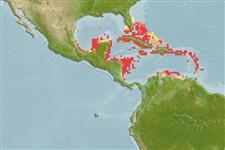>
Ovalentaria/misc (Various families in series Ovalentaria) >
Opistognathidae (Jawfishes)
Etymology: Opistognathus: Greek, opisthe = behind + Greek, gnathos = jaw (Ref. 45335); to the very elongate upper jaw of the type species of the genus, Opistognathus nigromarginatus (Ref. 128653).
More on author: Poey.
Environment: milieu / climate zone / depth range / distribution range
Ekologi
laut berasosiasi dengan karang; kisaran kedalaman 1 - 8 m (Ref. 89891). Tropical; 29°N - 10°N, 98°W - 59°W
Western Atlantic: southern Florida, USA and Bahamas to Central America, West Indies and Caribbean Islands.
Size / Weight / umur
Maturity: Lm ? range ? - ? cm
Max length : 13.0 cm TL jantan/; (Ref. 7251)
deskripsi pendek
Morfologi | Morfometrik
Duri punggung (Keseluruhan (total)): 11; duri punggung lunak (Keseluruhan (total)): 15; Duri dubur 3; Sirip dubur lunak: 15. Black spot in the dorsal fin is in the lower half of the fin and is usually located between the 6th and 9th spines; there is some brown pigment at the corner of the mouth but no black and white bands inside the maxilla (Ref. 13442).
Inhabits an elaborate burrow, often fairly deep (12 inches), and with a terminal chamber; the vertical shaft lined with coral and shell fragments. An oral brooder (Ref. 5521).
Life cycle and mating behavior
Kematangan | Reproduksi, perkembang biakan | Pemijahan | telur-telur | Fecundity | Larva
Males incubate the eggs in the mouth (Ref. 33037, 39363).
Robins, C.R. and G.C. Ray, 1986. A field guide to Atlantic coast fishes of North America. Houghton Mifflin Company, Boston, U.S.A. 354 p. (Ref. 7251)
Status IUCN Red List (Ref. 130435)
ancaman kepada manusia
Harmless
penggunaan manusia
Akuarium: Komersial
informasi lanjut
Umur / SaizPertumbuhanpanjang-beratpanjang-panjangukuran frekuensiMorfometrikMorfologiLarvaDinamika larvapemulihanKelimpahanBRUVS
AcuanBudidaya airprofil budidaya airStrainGenetikaElectrophoresesDiturunkanPenyakit-penyakitPengolahanNutrientsMass conversion
mitraGambarStamps, Coins Misc.Suara-suaraCiguateraKecepatanTipe renangArea insangOtolithsOtakPenglihatan / visi
Alat, peralatan
laporan khas
muat turun XML
Sumber internet
Estimates based on models
Preferred temperature (Ref.
123201): 26.4 - 28.1, mean 27.4 °C (based on 476 cells).
Phylogenetic diversity index (Ref.
82804): PD
50 = 0.5000 [Uniqueness, from 0.5 = low to 2.0 = high].
Bayesian length-weight: a=0.00389 (0.00180 - 0.00842), b=3.12 (2.94 - 3.30), in cm total length, based on all LWR estimates for this body shape (Ref.
93245).
Trophic level (Ref.
69278): 3.5 ±0.5 se; based on size and trophs of closest relatives
Fishing Vulnerability (Ref.
59153): Low vulnerability (10 of 100).
Nutrients (Ref.
124155): Calcium = 121 [62, 189] mg/100g; Iron = 0.719 [0.415, 1.204] mg/100g; Protein = 18.4 [17.3, 19.5] %; Omega3 = 0.0847 [, ] g/100g; Selenium = 21.6 [9.7, 45.7] μg/100g; VitaminA = 135 [43, 410] μg/100g; Zinc = 2.01 [1.34, 2.86] mg/100g (wet weight);
